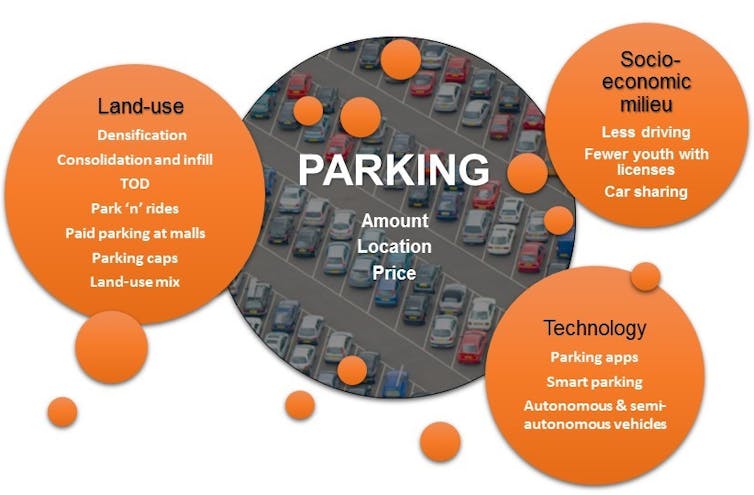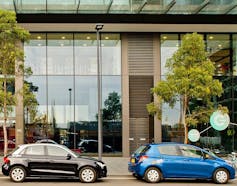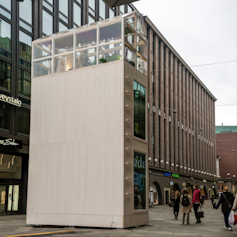Freeing up the huge areas set aside for parking can transform our cities
- Written by Dorina Pojani, Lecturer in Urban Planning, The University of Queensland
Parking may seem like a “pedestrian” topic (pun intended). However, parking is of increasing importance in metropolitan areas worldwide. On average, motor vehicles are parked 95% of the time. Yet most transport analysis focuses on vehicles when they are moving.
Substantial amounts of land and buildings are set aside to accommodate “immobile” vehicles. In Australia, Brisbane provides 25,633 parking spaces in the CBD, Sydney 28,939 and Melbourne 41,687. In high-demand areas, car parks can cost far more than the vehicle itself.
However, parking is not just an Australian problem. By some estimates, 30,000 square kilometres of land is devoted to parking in Europe and 27,000 km² in the US. This parking takes up a large part of city space, much of it highly valued, centrally located land.
Further reading: End of the road? Why it might be time to ditch your car
Traditionally, transport planners believed that generous parking allocations provided substantial benefits to users. In reality, excessive parking is known to adversely affect both transport and land use. These impacts, along with recent land-use, socioeconomic and technological trends, are prompting cities to start asking some important questions about parking.
Australian planners must engage with emerging trends to help cities work out the best way to reclaim and repurpose parking space in ways that enhance efficiency and liveability while minimising disruption.
Here we chart likely challenges and opportunities created by these trends over coming decades.
 Key trends affecting parking space in cities.
Diagram by authors
Key trends affecting parking space in cities.
Diagram by authors
Land use
All Australian cities have policies to encourage densification, consolidation and infill development in their centres. In conjunction, some cities are setting maximum limits on parking to prevent it taking over valuable inner-city properties.
Transit-oriented development (TOD) has also become popular, at least on paper. This is another form of urban consolidation around transit nodes and corridors. It is known to benefit from high-quality urban design, “walkability”, “cyclability” and a mix of functions.
These developments mean that people who live in CBDs, inner-ring suburbs and near public transport stops will use cars less. Consequently, demand for parking will decrease.
Further reading: Make housing affordable and cut road congestion all at once? Here’s a way
Some non-TOD suburbs are trying to replicate inner-city features as well. For example, some suburban shopping centres have introduced paid parking. This is a significant shift from previous eras, when malls guaranteed ample free parking.
Suburbanites who lack easy public transport access will continue to rely on cars. But rather than driving all the way to a CBD, commuters will increasingly opt for park-and-ride at suburban stations, thereby increasing demand for park-and-ride lots at public transport interchanges. However, excessive capacity might hurt rather than help patronage.
Social trends
In addition to land use, several social trends will affect the need for parking.
First, young people are delaying getting drivers’ licences because driving is culturally less important to them than in previous generations.
Second, people of all ages are moving from outer suburbs to inner cities. For many, this means less driving because walking, cycling and public transport are more convenient in inner cities.
 If each car share vehicle replaces roughly a dozen individually owned cars, that’s a big cut in demand for parking.
By Kako/Wikipedia, CC BY-SA
If each car share vehicle replaces roughly a dozen individually owned cars, that’s a big cut in demand for parking.
By Kako/Wikipedia, CC BY-SA
Finally, the emergence of Uber, Lyft and vehicle-sharing arrangements means that people are not buying cars. Research suggests that each car-sharing vehicle removes nine to 13 individually owned vehicles from the road.
Together, these trends point to a reduced need for parking because there will be fewer cars overall.
Technology
The importance of technology in parking is rising – paving the way for “smarter” parking.
The emergence of a host of smartphone apps, such as ParkMe, Kerb, ParkHound and ParkWhiz, has begun to reshape the parking landscape. For the first time, users can identify and reserve parking according to price and location before starting their journeys.
Apps also make available a host of car parks that previously went unused – such as spaces in a residential driveway. This is because there was no mechanism for letting people know these were available.
In addition, smart pricing programs, such as SFPark in San Francisco, periodically adjust meter and garage pricing to match demand. This encourages drivers to park in underused areas and garages and reduces demand in overused areas.
The advent of autonomous vehicles promises to have dramatic impacts on transport and land use, including parking.
According to one school of thought, mobility services will own most autonomous vehicles, rather than individuals, due to insurance and liability issues. If this happens, far fewer vehicles and parking spaces will be needed as most will be “in motion” rather than parked most of the time.
Further reading: Driverless vehicles could bring out the best – or worst – in our cities by transforming land use
More space for people and places
 The Tikku (Finnish for ‘stick’), by architect Marco Casagrande, is a house with a footprint of just 2.5x5m, the size of a car parking space.
Casagrande Laboratory
The Tikku (Finnish for ‘stick’), by architect Marco Casagrande, is a house with a footprint of just 2.5x5m, the size of a car parking space.
Casagrande Laboratory
The next decade promises much change as emerging land-use, socioeconomic and technological trends reshape the need for, and use of, parking. Cities will devote less space to parking and more space to people and places.
Parking lanes will likely be repurposed as cycling lanes, shared streets, parklets, community gardens and even housing. Concrete parking lots, and faceless garages will likely be converted to much-needed residential, commercial and light industrial use.
By transforming parking, much urban land can turn from wasteland into vibrant activity space.
Authors: Dorina Pojani, Lecturer in Urban Planning, The University of Queensland





